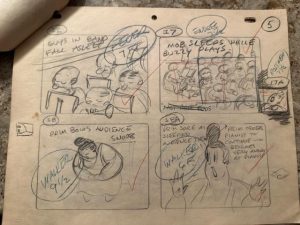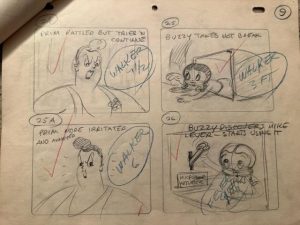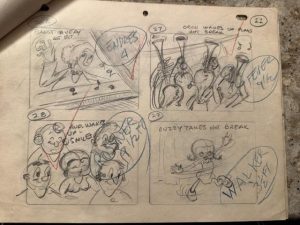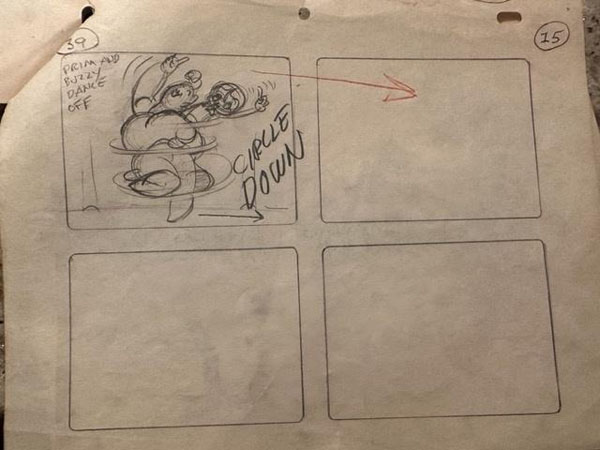Once a flagship series for Fleischer Studios, the Betty Boop cartoons waned in the later 1930s. Popeye the Sailor, a character licensed by King Features Syndicate, became the studio’s most popular character and overshadowed Betty, whose earthy appeal was weakened by the new Production Code. Buzzy Boop at the Concert is the second appearance of Betty’s young tomboy cousin after the titular Buzzy Boop, released in July 1938.
The director boards (below) indicate that Tom Johnson’s crew in mid-1938 consisted of Frank Endres, Harold Walker, Otto Feuer, and Lod Rossner; Johnson chose to animate a few close-up shots himself.
Otto Feuer (1907-1998) emigrated to the United States from Germany in 1925. Like many Fleischer artists, Otto attended Cooper Union in New York, where he graduated in 1932; he joined Max Fleischer’s studio a year later, presumably as an inker or opaquer. According to Fleischer’s Animated News, Otto was an in-betweener by May 1935; he became a full animator in Tom Johnson’s crew in 1936. Otto stayed with the Fleischers during their transition to Miami in 1938; he remained when the company was renamed Famous Studios in 1942 after Paramount ousted Max and Dave. Shortly after the animators returned to New York in 1943, Otto moonlighted in funny-animal comic book magazines. When Otto left Famous in October 1945, he became a prolific artist for DC, penciling stories with Peter Porkchops, Dodo and the Frog, and The Raccoon Kids.

Dave Tendlar model sheet for the character Buzzy Boop
Lodowick “Lod” Rossner (1906-1978) studied at Pratt Institute in New York. He worked as a vacuum salesman before joining Max Fleischer in 1930-31. In June 1935, Rossner moved into Willard Bowsky’s unit as a full animator but later shifted to Tom Johnson’s unit. (The 1950 Los Angeles census listed Rossner’s occupation as an artist for “furniture building.”)
 Tom Johnson’s thumbnail sketches mention Madame Shrill’s performance of “Last Rose,” a shortened descriptor of “The Last Rose of Summer” (from Friedrich von Flotow’s opera Martha), sung in the first half of the film. Likewise, Shrill’s second song is “Lo, Here the Gentle Lark,” from Henry Bishop’s comedy adaptation of Shakespeare’s The Comedy of Errors. The thumbnails also note when the bosomy prima donna sees the audience’s enthusiasm over the swing music instigated by Buzzy, the two dance ‘the Big Apple’ together, a dance craze that rose in popularity in 1937-38. Near the end of the film, Madame Shrill and Buzzy dance to Sam Coslow’s “Jammin’,” from the 1937 Paramount feature Turn Off the Moon. Fleischer musical composer Sammy Timburg also used the tune in Let’s Celebrake, when Popeye and Olive Oyl’s feeble grandma, rejuvenated by the power of spinach, swing together at a dance hall on New Year’s Eve.
Tom Johnson’s thumbnail sketches mention Madame Shrill’s performance of “Last Rose,” a shortened descriptor of “The Last Rose of Summer” (from Friedrich von Flotow’s opera Martha), sung in the first half of the film. Likewise, Shrill’s second song is “Lo, Here the Gentle Lark,” from Henry Bishop’s comedy adaptation of Shakespeare’s The Comedy of Errors. The thumbnails also note when the bosomy prima donna sees the audience’s enthusiasm over the swing music instigated by Buzzy, the two dance ‘the Big Apple’ together, a dance craze that rose in popularity in 1937-38. Near the end of the film, Madame Shrill and Buzzy dance to Sam Coslow’s “Jammin’,” from the 1937 Paramount feature Turn Off the Moon. Fleischer musical composer Sammy Timburg also used the tune in Let’s Celebrake, when Popeye and Olive Oyl’s feeble grandma, rejuvenated by the power of spinach, swing together at a dance hall on New Year’s Eve.
Buzzy Boop at the Concert was released on September 16, 1938. The November 1, 1938 edition of The Miami News wrote: “Fleischer officials said that they hope the public will take a fancy to Buzzy and make her a permanent tenant of the new Fleischer studios.” Buzzy did not make another appearance in a Betty Boop cartoon.

The following month, Sally Swing was issued to theaters, supported by a boastful promotional push in film trades, touted as “a lively little lady who will keep ’em jammin’ in your box office.” In its May 21 issue, The Hollywood Reporter noted that Sally Swing was an attempted launch at a new series that would replace Betty Boop. The Fleischers proposed its first season with twelve pictures, including her debut—the other cartoons never materialized. Betty Boop appeared in her final cartoon, Rhythm on the Reservation, released in July 1939.

Note the fingers.
One last note about the production boards: scene 20 is jointly credited to Tom Johnson and Frank Endres. Upon closer inspection, Frank Endres drew Buzzy’s fingers tapered to a point, as he did with the other characters in this film, whereas in scene 20, Buzzy’s fingers are drawn more rounded and “cartoony.” Frank Endres might have received credit for the reused animation of the incidental characters, while Tom Johnson animated Betty and Buzzy; perhaps Johnson took the scene from Endres to make the deadline. (click each board to enlarge)















Andy Chance, Tom Johnson’s nephew, provided the production materials for this post. Jerry Beck and Bob Jaques also contributed input for the text.



 DEVON BAXTER is a film restoration artist, video editor, and animation researcher/writer currently residing in Pennsylvania. He also hosts a
DEVON BAXTER is a film restoration artist, video editor, and animation researcher/writer currently residing in Pennsylvania. He also hosts a 





















































































Not that long ago, “Buzzy Boop at the Concert” was a lost cartoon that had not been seen by anyone in the world in literally decades. Now, we have not only a fine restoration of it from UCLA, but all this detailed information about its making. I am very happy about this, and hopeful for the prospects of other lost cartoons someday being brought back to light from oblivion.
While “The Last Rose of Summer” is indeed an aria in the opera “Martha”, Friedrich von Flotow did not compose the melody, which is a traditional Irish folk tune that had been set to a poem of the same title by Thomas Moore in the early 1800s. It was already a well-known song long before Flotow incorporated it into his opera. Beethoven included it in one of the sets of songs from the British Isles that he compiled late in his life, and an arrangement of it for solo harp was a signature tune of French harp virtuoso Nicolas-Charles Bochsa, who, by coincidence, is probably best remembered today for carrying on a long and very public affair with operatic soprano Anna Bishop, the second wife of Sir Henry Bishop, composer of “Lo, Here the Gentle Lark”, the other song featured in “Buzzy Boop at the Concert”.
Lod Rossner’s experience as a vacuum cleaner salesman was no doubt brought to bear on Tom Johnson’s crowning achievement, “The Hot Air Salesman”, with his immortal creation Wiffle Piffle in the title role. “Nothing today, kind sir!”
Great post as always, Devon!
The voice of Sally Swing was the actress and comedienne of later years, Rose Marie – then only 15 years old. Including her star turn in The Dick Van Dyke Show, she had probably the longest career of any entertainer, spanning 90 years.